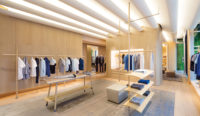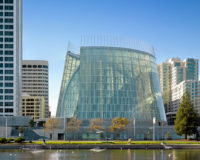Rome
Boutique hotels have emphatically advanced the notion of modern design in the hospitality market. Evolving in reaction to file-box chain hotels of the 1950s and '60s, these smaller lodgings, each with a distinct ambience, often arrive at a formula: minimal architecture, arty furnishings, and loud piped-in music aimed at a young crowd.
Palazzo Montemartini, built and expanded from 1885 to 1920 as a headquarters for the local bus and streetcar lines, has been knit together by King Roselli Architetti to create a modern caravansary inside an older shell. Working with Ottaviano Architetture, which specializes in restoration, engineering, and project management, the Rome-based practice of Jeremy King and Riccardo Roselli took charge of designing guest rooms and suites, a restaurant-lounge, conference room, spa, and lobby. Given King Roselli's extremely futuristic Sheraton Milan Malpensa Airport Hotel, it is not surprising to find here some of the streamlined curves and shimmering surfaces that glamorize that building's public spaces.
As visitors enter the Palazzo Montemartini, they encounter a small lobby enclosed by white planes of frosted glass. At the reception area, a mirror-finished aluminum soffit merges with the back wall. Onyx panels, attached to wood frames and lit from behind, offer a sensuous counterpoint to the planar quality of the space. Between the onyx panels, faint rivulets of water trickle down the grooved, solid-surface walls on which the luminous blocks are mounted— an aqueous theme that repeats itself throughout the hotel. “The idea of water informs the spaces to refer to the Baths of Diocletian next door,” says King.
Also on the ground floor is the large restaurant-lounge that occupies the former lobby and ticket office in the public transport facility. The grandly scaled fluted columns, ceilings, and other architectural ornamentation of this landmarked space needed to be restored. To give a sense of intimacy to the room, the architects placed a table-height rectangular fountain in the center. Its steel structure, surfaced in black fiberglass with a gelcoat finish (like the long buffet bar along one side), forms a basin for water trickling down vertical mylar cords above it.
On the lower level, King Roselli developed a version of modern-day baths for a lushly sedate, subterranean spa, where three pools are atmospherically lighted in pale shades of rose, blue-green, and yellow. Even upstairs, one line of guest accommodations includes small swimming pools.
Overall, the architects generated seven types of guest rooms, largely to solve changes in floor levels and other quirks that come from tucking hotel space into an existing structural frame of reinforced concrete and brick walls.
Some junior suites on the second floor retain the original wood and glass doors, ornamented ceilings, and other painted and carved traces of the past. But most guest rooms make the connection to history through the use of natural materials: smooth surfaces of sandstone (especially for bathroom fixtures and counters); terrazzo floors; oak cabinetry; and leather for chairs, armoires, daybeds and bedsteads, designed by King Roselli. While the architects collaborated with local tradespeople for fabricating their designs, when it came to lighting, they searched for fixtures and lamps created by such modern stalwarts as Gio Ponti, Ingo Maurer, and Achille Castiglioni.
Clearly, this hotel, with its total-design approach, discourages duplication, as attested by the guest rooms with small pools and split-level plans. It serves an affluent market of visitors who shun the bold and the trendy, on one hand, and large, grand baroque piles with overstuffed furniture on the other. The people whom the client, the Ragosta Hotels Collection, hopes to attract, are seeking the imaginative and experimental in design—but without sacrificing a sense of luxe, calme, and volupté.
People
Owner:
Architect:
Personnel in architect's firm who should receive special credit: Project architect: Katia Scarioni Architects: Valeria Alfonsi, Daniele Del Prete
Interior designer:
Consultant(s):
General contractor:
Photographer(s): Size: 97,000 square feet Construction cost: $24 million Completion date: January 2014 |
Products
Windows Metal frame: Secco Sistemi
Glazing
Skylights:
Doors Wood doors: guest rooms: Albed Sliding doors: Geze
Fire-control doors, security grilles: Acoustic doors: Tino Sana
Hardware
Interior finishes
Paints and stains:
Wall coverings:
Paneling:
Solid surfacing:
Floor and wall tile:
Carpet: Furnishings
Public spaces furniture:
Chairs:
Tables:
Upholstery:
Guest room furniture:
Tables:
Upholstery:
Public Spaces:
Lobby Fountain:
Lounge Fountain:
Guest rooms:
Light switches:
bathrooms mirror:
Lighting
Public Spaces:
Guest rooms:
Conveyance |















Post a comment to this article
Report Abusive Comment